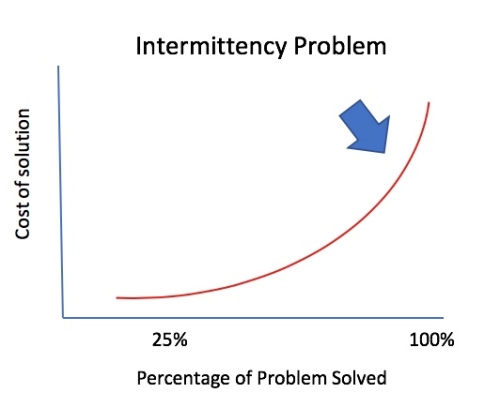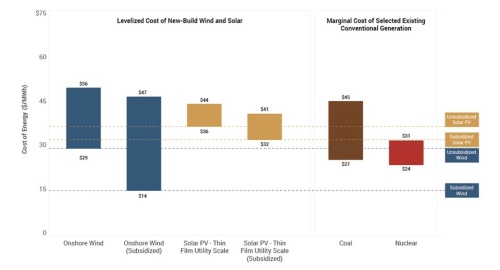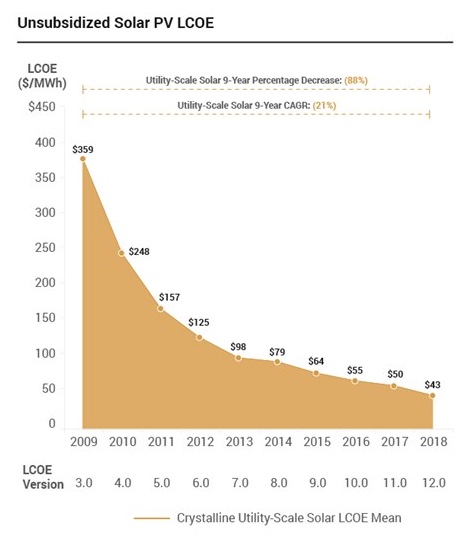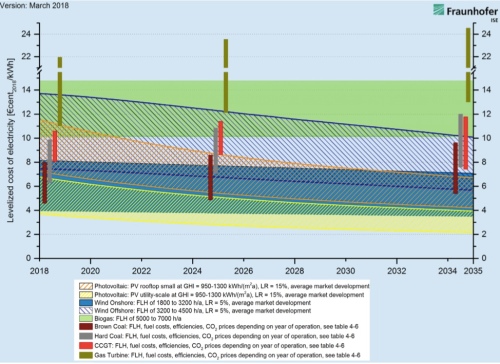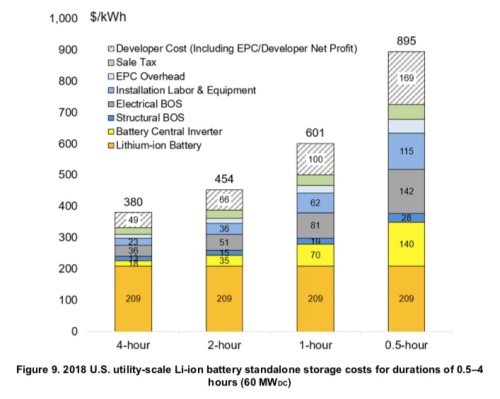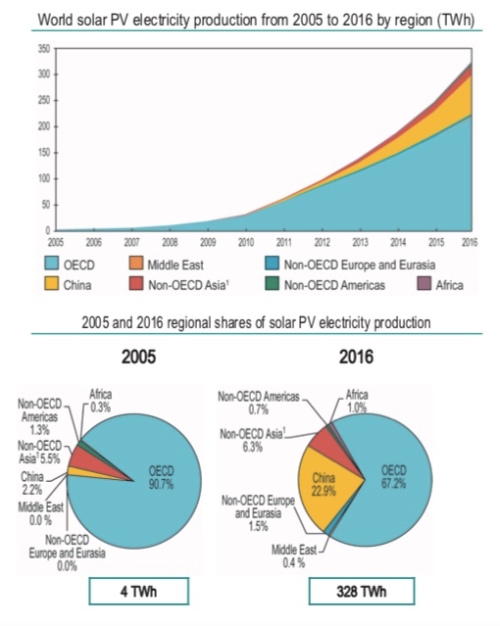In my last post, I mentioned that the late Cambridge University professor David Mackay was skeptical over the ability of solar to play a lead role in decarbonising the world’s energy infrastructure. MacKay’s highly influential book “Sustainable Energy Without the Hot Air” is rooted in basic science. Yet, despite the text being peppered with scientific identities, it also includes a number of value judgements that touch on the world of economics. And it is from these value judgements that MacKay’s skepticism arises.
MacKay’s book is principally concerned with what it would take to decarbonise the UK economy. Tony Seba, in contrast, forecasts that solar can power the globe not just the UK. In this post, I will stay with the UK, although I will look at other countries in future posts. Nonetheless, for Tony to be right, each and every country must be able to secure its energy needs through solar including the UK (though the solar energy may be imported from abroad). Accordingly, if Mackay’s argument is right (that is that the UK’s solar resource in inadequate) then Tony’s is wrong (notwithstanding the import argument).
Two of the major pushbacks against solar rest on the land mass requirement for sufficient energy generation and the intermittent nature of solar that puts unbearable stresses on the grid. As a former economist by training, I regard such arguments as second-order ones. They are both really subsumed under cost issues. Land is just a scarce resource like any other, and if the return on the land used for solar is higher than that for any other use, then it should be allocated to solar-power usage (that calculation can take into account the cost of climate change and the public good value of land).
Moreover, the unit of energy we are working with in this post, a kilowatt hour, is quite simplistic in economic terms. Energy is demanded at a particular place and at a particular time (hour of the day, and day of the year). A kilowatt hour generated in mid-summer in Spain in July, it not the same thing as a kilowatt hour consumed in mid-winter in London in January. The levelised cost approach (I will have a lot to say on that in future), which is used to compare different energy-producing assets, doesn’t take time and place into account.
In reality, we can think of the energy market as composed of 8,760 hour-long blocks (24 hours times 365 days) with a GPS attached to each one. In each of these GPS-stamped timed blocks, the market will equalise supply and demand at a certain price.
MacKay’s analysis only implicitly addresses the economics. Nonetheless, before we start moving energy through time and space, we must ensure that we have enough energy to move in the first place. MacKay does tackle that question.
In a section of his book titled “Fantasy time: solar farming”, Mackay conducts a thought experiment within which he covers 5% of the UK land with 10%-efficient solar photovoltaic panels.

He starts by calculating that “the average raw power of sunshine per square metre of flat ground (in the UK) is roughly 100 W/m2″. However, with a 10% efficiency photovoltaic panel, of the 100 W/m2 only 10 W/m2 is converted into electricity. From my last post we also know that if we leave a 40W light bulb on all day, it will use up nearly 1 kWh of power (0.04kW times 24). So if we generate 10 W per a one metre squared solar panel, we will get a quarter of that in energy, or 0.25 kWh. MacKay in his calculation has allocated 5% of the UK’s land mass to be used for solar power, which gives 200 m2 to each UK citizen. Times 200 by 0.25 kWh and we get 50 kWh per person per day, which compares with total energy demand of 125 kWh per person per day.
Also, as an aside, note that his calculation goes from power (solar irradiance measured in watts or kilowatts) into an energy number (solar insolation measured in watt hours or kilowatt hours).
At this point, let’s take a step back and look at that allocation of 5% of the UK’s land mass to solar panels. The UK land area is 25.25 million hectares and the population 66 million. Divide one by the other and we get around 0.38 hectares per person, (or just under an acre), which is the same thing as 3,800 m2. MacKay gives each person in the UK 4,000 m2 of land each since the population of the UK was about 5 million smaller when he was working out the maths. However, these numbers are near enough.
Switching from metres squared per person to number of persons per square kilometre, which is the standard measure when comparing countries, I have put together a table of population densities for selected countries, mostly ones with large populations, below. Note that a hectare (10,000 m2 ) is 0.01 of a square kilometre, so 0.4 hectares (40,000 m2 or 0.004 square kilometres) per person translates into 250 people per square kilometre.

From the table we can see that only the Netherlands, Japan, the Philippines, India and Bangladesh have population densities higher than the UK. So if the UK can become energy self-sufficient via solar it bodes very well for the rest of the world (putting differing solar irradiance numbers for each country aside for the time being). Moreover, the really profligate energy users, like the USA and Australia (which get through over twice the energy per person than the UK), have the advantage of having a lot of land.
Back to the UK and MacKay’s fantasy time solar farming:

That 50 kWh per day per person amounts to 40% of the UK’s energy consumption of 125 kWh per person per day. Accordingly, if we hold our 10% panel efficiency steady, then to meet 100% of UK energy requirements we would need to cover 12.5% of the UK land mass with solar panels (about 500 m2 per person).
Critically, MacKay headed his calculation “fantasy time” since he felt the calculation rested upon an unrealistically high cost. Fortunately, this is one area where MacKay was wrong (and Seba right): those fantasy cost reductions have come true (from Bloomberg‘s New Energy Finance (BNEF)‘s New Energy Outlook 2018):

In short, MacKay was far too pessimistic when it came to the cost curve. BNEF calculates a learning rate of 28.5% for solar PV. The learning rate 28.5% means that every time production capacity for solar PV panels is doubled, the cost of those panels comes down by 28.5%. This is an example of a virtuous circle: lower costs spur greater demand for the panels, which spurs greater production, which spurs future cost cuts and thus greater demand — and so the cycle goes on. (Of course, the panels are not the only components that go into a utility sized solar farm and all the other components will have their own learning curves and, hopefully, declining cost curves. We will come back to that in a later post.)
We are 10 years on from when MacKay wrote Without the Hot Air and already solar is overtaking all existing sources of fossil-fueled energy production in terms of cost competitiveness. Of course, there is a big caveat here: production costs are very different from the cost to deliver energy to a customer at a particular time and at a particular place as I have flagged above. Nonetheless, MacKay was worried about how solar stacked up cost-wise on a production basis out to 2050. That worry was misplaced.
How audacious is this plan? The solar power capacity required to deliver this 50 kWh per day per person in the UK is more than 100 times all the photovoltaics in the whole world. So should I include the PV farm in my sustainable production stack? I’m in two minds. At the start of this book I said I wanted to explore what the laws of physics say about the limits of sustainable energy, assuming money is no object. On those grounds, I should certainly go ahead, industrialize the countryside, and push the PV farm onto the stack. At the same time, I want to help people figure out what we should be doing between now and 2050. And today, electricity from solar farms would be four times as expensive as the market rate. So I feel a bit irresponsible as I include this estimate in the sustainable production stack in figure 6.9 – paving 5% of the UK with solar panels seems beyond the bounds of plausibility in so many ways.
A second observation (or criticism) is that MacKay seems to have also been too pessimistic in term of not just his cost assumption but also efficiency. In the above calculation, MacKay used 10% efficiency panels:
I assumed only 10%-efficient panels, by the way, because I imagine that solar panels would be mass-produced on such a scale only if they were very cheap, and it’s the lower-efficiency panels that will get cheap first.
In reality, those crystalline-silicon PV modules shown in the BNEF report above are far more efficient. From the United States Department of Energy:
Crystalline silicon PV cells are the most common solar cells used in commercially available solar panels…..
……Crystalline silicon PV cells have laboratory energy conversion efficiencies over 25% for single-crystal cells and over 20% for multicrystalline cells. However, industrially produced solar modules currently achieve efficiencies ranging from 18%–22% under standard test conditions.
True, these efficiencies are at the panel level not at the solar farm level. A utility scale solar facility will also need room for inverters, control panels, transmissions mechanisms, maintenance huts, security facilities and so on. Yet, we are already at around 20% efficiency levels for commercial products in 2019. Even if we knock off a few percentage points of efficiency to take account of ground cover occupied by stuff needed for a solar installation other than the panels, we are still far above MacKay’s efficiency figure.
A second area where MacKay was far too pessimistic with respect to the technology relates to the Shockley-Queisser limit. This limit sets the maximum theoretical upper efficiency limit of a single layer solar cell to around 33%. However, a new generation of multijunction cells has hopped over the Shockley-Queisser limit. With a two-layer cell your theoretical ceiling is 44% and with three layers 50%. The US National Renewable Energy Laboratory (NREL) shows the major improvements achieved in the past and those predicted for the future. The energy academic Varun Sivaram also devotes a chapter in his book “Taming the Sun” to these frontier PV technologies.
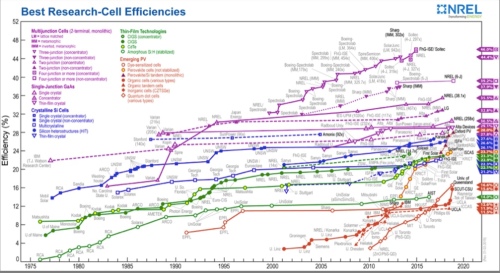
Currently, the really super-high efficiency panels that are up at 40% are not cost competitive enough to adopt for commercial use. Further, most have drawbacks in terms of manufacturing cells at sufficient size and also with respect to building cells durable enough to be deployed in real-world field conditions. Yet results to date suggest the more efficient panels have kept migrating out of the laboratory and into the marketplace at an ever-falling price.
Given where we are now in terms of panel efficiency and where we will likely be in 10 years time, it is possible that the 200 m2 of land allocated by MacKay to every UK citizen for solar panels could actually meet all the UK energy needs; that is, 125 kWh per person per day if we were deploying 25% efficiency panels (provided that the energy could be transferred though time and space). Further, once solar PV technology can be incorporated into roof tiles and road pavings, not all of the required space need be taken from agriculture land (figure below taken from Without the Hot Air“).

Then, of course, we could add energy generated from wind into our mix. Each additional kWh coming from wind energy means one less kWh needs to come from solar energy. Tony Seba’s focus was on solar, but I see solar and wind as inseparable twins.
Overall, Mackay was far too pessimistic over the ability of solar to come down its cost curve. In my next post, however, I want to look at an even more potent argument against the future primacy of solar. The blogger Euan Mearns and his co-contributor Roger Andrews are not huge fans of renewables and feel the displacement of solar is a pipe dream of green fantasists. We shall see what they have to say.


